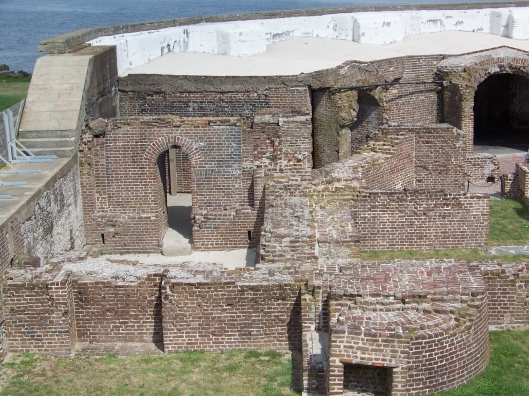Piping-hot beef stew is one of my comfort foods, and we have had a winter that has begged for comfort food. What a long and hard winter this has been! The aroma from the Beef Stew and Dumplings I had started early in the day made the snow and sleet falling outside much less depressing. I love snow, but not in March! But there is hope…we also got to watch a St. Louis Cardinal pre-season game on television as the stew was cooking. Spring MUST be somewhere…just around the corner. And with that little personal note aside, we return to Charleston, SC one last time, for a visit to Fort Sumter National Monument. But first I want to say something about where we stayed while in Charleston. The Barksdale House Inn is a beautiful Regency style residence built by Thomas Barksdale sometime between 1778 and 1817. It is in the historic Ansonborough neighborhood, Charleston’s first suburb, also known as the “Bowling Green”. The Inn has 14 rooms furnished in period style with many antiques. The floors are original to the house. Behind the inn is a beautiful garden where we relaxed several evenings with a complimentary glass of sherry. It is moderately priced and is within walking distance of the historic district. Off street parking is also available. You can find out more about the Barksdale House Inn at their website, http://barksdalehouse.com.

The Barksdale House Inn was a comfortable home away from home each evening after long days of sight-seeing.
Fort Sumter National Monument
On our second day in Charleston, we made our way down to the Fort Sumter Visitor Education Center, where we boarded a ferry that took us out to the fort, which is situated in Charleston Harbor. Walking in Charleston is always enjoyable and, once again, we took in many beautiful views of the city.

We saw so many beautiful and beautifully restored old homes.

One of the many churches in the “Holy City”.

City Market

A tree-lined cobblestone street that leads to the harbor.

Beautiful flowering trees and shrubs all along the way.
The ferry service that takes you to Fort Sumter allows for many more views of the city skyline and surrounding attractions. You can see the USS Yorktown, anchored in the harbor and open to visitors.

The USS Yorktown anchored in Charleston Harbor.

Approaching Fort Sumter on the ferry.

The Fort Sumter ferry at anchor while passengers explore the fort.

A view of the Lowcountry from Fort Sumter.
On December 26, after South Carolina became the first state to secede from the Union, Major Robert Anderson, commanding officer at Ft. Moultrie on Sullivan’s Island, moved his men to the yet unfinished Fort Sumter. He felt his troops would be safer at this location which is out in Charleston Harbor. He soon faced serious problems trying to resupply Fort Sumter with food and other necessities.
We have always been taught that the first shots of the Civil War were fired in April, 1861. But by that time growing hostilities between the North and South had already resulted in gunfire. On January 8, 1861, as the ship Star of the West attempted to deliver much needed supplies to the fort, it was fired on by cadets at the Citadel. The shots historians have marked as the beginning of the Civil War were fired on April 12, 1861, when negotiations for the surrender of the fort to the Confederate Army failed. General P. G. T. Beauregard ordered the attack from nearby Johnson Island. The bombardment of Fort Sumter lasted for thirty-four hours and on April 13, 1861, Major Anderson surrendered the fort to the Confederate Army.
Fort Sumter was in ruins following the war and the US government worked to restore it as a military installation. From 1876-1897, Fort Sumter served as an unmanned lighthouse station, but it was never again engaged in combat.
Views of Fort Sumter



You can learn more about Fort Sumter National Monument by going to their website at http://www.nps.gov/fosu.
Feeding the Army in South Carolina
Before hostilities escalated as the Civil War approached, the troops at Fort Moultrie were able to attain fresh food supplies, such as meat and vegetables, from vendors in Charleston. These, together with the provisions provided by the government, ensured that the soldiers had good, nutritious meals. However, with the move to the unfinished Fort Sumter, obtaining good food and provisions became a serious problem.
In January, the supply ship Star of the West had been fired on by cadets at the Citadel. By April 7, the men at Fort Sumter had only forty-eight hours of fresh food available. Even worse, they had no way of preserving any of the food. In addition, their supply of government issued provisions was running very low.
But for our purposes– and because it tastes good–we will concentrate on the times they were able to eat well. The men at Fort Moultrie would have had good meals with meat and fresh vegetables. They would have often eaten soups and stews. Many years ago, I purchased a cookbook entitled Blue and Grey Cookery; Authentic Recipes from the the Civil War Years. It was written by Hugh and Judy Gowan and published by Daisy Publishing of Martinsburg, PA. One of our favorite recipes from this collection is for a stew loaded with beef in a delicious gravy. This is the comfort food that makes this cold March day seem more bearable! I am sure you will agree that the primary reason it is so comforting is that it is a no-frills recipe that tastes just oh-so good. Enjoy!

Comfort food on a cold, blustery day!
Beef Stew with Dumplings
- 2 to 3 lbs. beef chuck
- 1/2 cup flour
- 1 tsp. salt
- 1/2 tsp. pepper
- 1 medium onion
- 1/2 cup cut carrots
- 1/2 cup cut turnips
- 4 cups potatoes, quartered
- 1 pint crushed stewed tomatoes
Remove the meat from the bone and cut it into 1 1/2 inch cubes. Dredge the cut beef in a mixture of the flour, salt and pepper. *Use a piece of fat cut from the chuck to render fat for browning the meat. Brown the meat in the rendered fat. Add the tomatoes and enough boiling water to cover the meat. Cover and simmer for 2 hours and then add the onions, carrots and turnips. Simmer for 40 minutes more and add the potatoes. Simmer for 20 more minutes. Adjust the seasoning to taste. At this point you are ready to add the dumplings (recipe follows).
After the dumplings are finished, you can make a gravy by removing the meat, vegetables and dumplings and thickening the liquid by adding a mixture of 1/4 cup flour and 1/2 cup cold water. This needs to be stirred constantly for 5 minutes.
* Using the fat from the beef instead of an oil for browning your meat will make a great difference in your stew. Not only does it add beefy flavor, but it also gives you a head start on creating that very yummy brown food flavor. It is worth the effort.

Dumplings
- 2 cups flour
- 4 tsps. baking powder
- 1 tsp. salt
- 1 Tbsp. shortening
- 1 cup milk
Sift the flour, baking powder and salt together and cut in the shortening. Add the milk and stir to make a soft dough. Turn up the stew to a rapid boil and drop the dumplings in by spoonfuls. The dumpling batter should not be immersed in the liquid. You can drop the batter on pieces of meat or vegetable. Cover tightly and cook rapidly for 15 minutes…don’t peek!
~~~
I have enjoyed sharing our visit to Charleston on my blog. I hope you might also take some time to make a trip to this great American city and enjoy its unique history and rich traditions. I also hope that you take the opportunity to try some good army food!

































